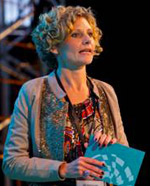By: Susanna Bill
All organizations face wicked problems – highly complex issues demanding multiple viewpoints to be solved. In this blog Susanna Bill argues why innovation needs to leave the single product dominant perspective behind and take social aspects into consideration.
The European Union has created a Digital Agenda in which the strategy for how we as Europeans will make the best out of the opportunities offered through digitalization of information for the forthcoming years. Areas included are e.g information stored in healthcare records, map data and traffic information. Out of the European Digital Agenda Sweden has created its own version and the Swedish IT minister Anna-Karin Hatt is travelling all around the country in order to get buy in from the municipalities.
The Swedish Digital Agenda
Here, in the south of Sweden, the core contribution to the Swedish Digital Agenda will be open data and how to create services out of data available in the official systems. Enthusiastic entrepreneurs are willing and able to turn rather blunted data into sharp services and wait eagerly for the municipality to push the button and open up its system. The municipality on the other hand, worries about not only data protection laws but about integrity issues with exposing data about its citizens and does not seem to know how to get out of the inability to act. Despite similar issues though, regions in Denmark, Finland and Norway to mention a few are already putting services out on their markets. So the Municipality has to act. This is an issue of high complexity to say the least, or what researchers Horst Rittel and Melvin Webber defined as a wicked problem.
Wicked problems
Wicked problems have a weak, if any connection to present business. They are highly ambiguous involving complex interdependencies and often conflicting interests from a wide range of stakeholders. The potential value when addressing wicked problems is however, vastly higher albeit a much greater risk of failure to realize the value. In addressing wicked problems, firms cannot rely on single individuals or one dominant perspective. Instead they need to make use of the collective knowledge and insights of the different stakeholders.
The Swedish Municipality is not the only organization facing wicked problems. The truth is that the fast moving global changes adds complexity to the extent that all organizations face wicked problems. The only way to successfully address such complex problems and attain the value is to invite more people to the table, thus to let go of the product related definition of innovation work and start addressing the social aspects of innovation.
The mechanisms of problem solving can be divided into two: that of ambiguity reduction and that of uncertainty reduction.
The mechanisms of problem solving can be divided into two: that of ambiguity reduction and that of uncertainty reduction. Ambiguity reduction entails problem framing due to lacking insights in what the problem at hand is. Unless the problem is framed it cannot be solved. Uncertainty reduction on the other hand entails solving the framed problem by filling the gap between existing and needed information and knowledge. Wicked problems must be framed before being solved, i.e the level of ambiguity is reduced prior to uncertainty reduction.
Reducing ambiguity is tough. If you do not know what the problem at hand is, how do you start and how can you be certain that you frame the right problem? Unfortunately there are no universal cook book solutions. It takes courage and time. One thing holds true though, it is easier for a group to be brave compared to a single individual. In a group one member’s weakness may be another member’s strength. Sharing insights and a joint goal creates the strength needed to dare to frame the problem in the best possible way.
The Municipality in the Southern part of Sweden has indeed taken a step forward in that they invited entrepreneurs, researchers, government representatives and local authorities to a round table discussion to discuss how new services that are beneficial to the citizens of Southern Sweden can be created through collaboration. This is a good start, but nothing more than that. In order to successfully carry out such a journey the work must be truly collaborative with a shared agenda and shared accountability of its results.
Closing thoughts
All organizations face wicked problems. Wicked problems are wicked because they cannot be solved using one dominant perspective, which is the most common modus operandii. Instead a web of different viewpoints is the only way to frame and solve a wicked problem, demanding a broader definition of innovation, and taking the social aspects into consideration. Inviting different viewpoints to the table is challenging and takes time. In fact research proves that you need to spend at least three hours on a topic to get into the depths of an issue. When was the last time you spent three consecutive hours on one issue?
About the author
 Susanna is the former Head of Innovation at Sony Ericsson Mobile Communications. In 2009 she founded Sustenance AB and since then shares her time between advising corporate leaders in how to make innovation happen by strengthening the innovation capabilities of their organizations, and pursuing a PhD at the department of Design Sciences at Lund University, focusing on the social processes that are beneficial for the innovation capabilities of self organizing teams. Susanna is a sought after speaker and panelist and the moderator of Innovation in Mind conference.
Susanna is the former Head of Innovation at Sony Ericsson Mobile Communications. In 2009 she founded Sustenance AB and since then shares her time between advising corporate leaders in how to make innovation happen by strengthening the innovation capabilities of their organizations, and pursuing a PhD at the department of Design Sciences at Lund University, focusing on the social processes that are beneficial for the innovation capabilities of self organizing teams. Susanna is a sought after speaker and panelist and the moderator of Innovation in Mind conference.
